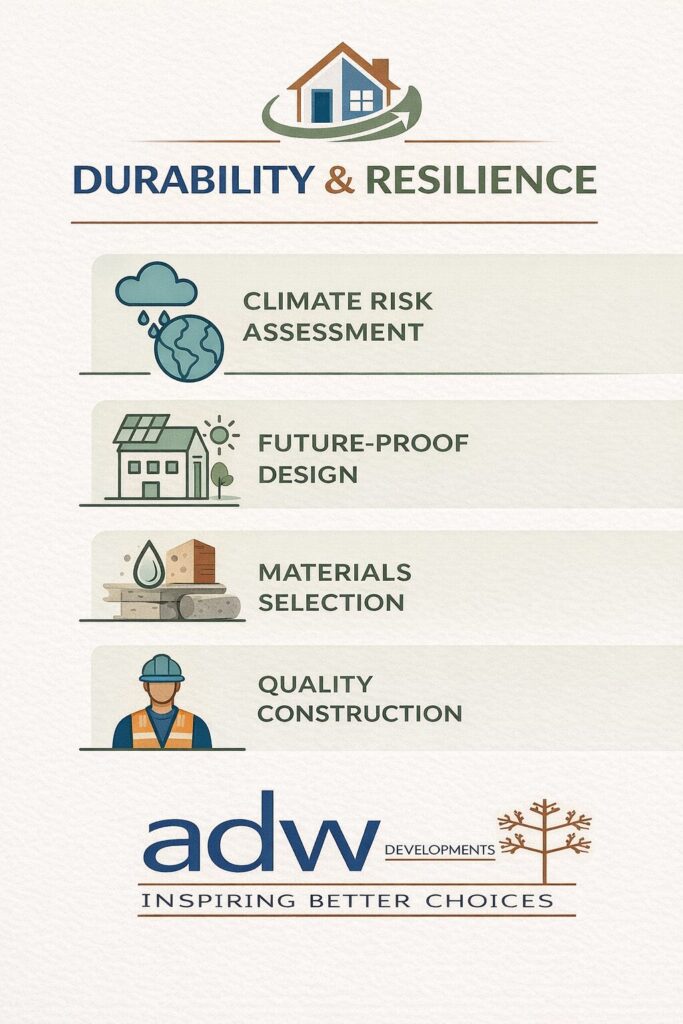Durability and resilience are essential for buildings to withstand climate extremes, resource pressures, and shifting user needs. Today’s Knowledge Share explores how robust materials, resilient design, and adaptable systems can reduce Whole Life Carbon, preserve long-term value, and create a built environment suitable for the future.

Defining Durability and Resilience in the Built Environment
Although often used interchangeably, durability and resilience have distinct but complementary meanings in construction. Importantly, understanding these differences is crucial to embedding both effectively.
Durability
Durability refers to the ability of a building or its components to maintain performance over a specified period under expected environmental and operational conditions, without unforeseen maintenance or repair. It is about longevity and resistance to degradation. Fundamentally, durable buildings resist wear and tear, chemical attack, weather extremes, and other forms of deterioration. In practice, key aspects include:
- Material selection: Choosing materials resistant to decay, corrosion, and fatigue (e.g. high-quality concrete, treated timber, corrosion-resistant metals).
- Construction quality: Ensuring correct detailing, installation, and workmanship to prevent premature failure.
- Maintenance regimes: Implementing effective inspection and maintenance programmes to identify and address issues early.
- Service life planning: Designing components with a clear understanding of their expected lifespan and replacement cycles.
Resilience
Resilience refers to the capacity of a building, community, or system to prepare for, withstand, respond to, and recover from disruptive events. These may include natural disasters (earthquakes, floods, storms, wildfires), climate change impacts (heatwaves, sea-level rise), or technological, economic, and social shocks. By contrast, resilience is about adaptability and recovery. Specifically, key aspects include:
- Resistance: Absorbing the impact of a disruptive event without significant damage or loss of function.
- Redundancy: Ensuring back-up systems or alternatives are available to maintain critical functions.
- Resourcefulness: Adapting and innovating in response to unforeseen challenges.
- Recovery: Restoring functionality quickly and efficiently after disruption.
- Adaptability: Adjusting to changing conditions over time, particularly as climate impacts intensify.
In short, durability allows buildings to last under normal conditions, while resilience enables them to survive and recover from abnormal or disruptive events.
Why Durability and Resilience Matter More Than Ever
The growing frequency of extreme weather events, coupled with the long-term effects of climate change, has made durability and resilience essential requirements for all buildings. At the same time, global resource constraints and rising user expectations have further increased their importance.
Climate Change Adaptation
Buildings must be prepared for rising temperatures, more intense rainfall, flooding, and stronger winds. Hence, durable materials and resilient design strategies, from flood-resistant foundations to robust building envelopes, ensure functionality during and after such events, reducing disruption.
Resource Scarcity and the Circular Economy
Durable buildings consume fewer resources over their lifetime, requiring less frequent repair or replacement. As a result, this reduces demand for raw materials, minimises waste, and aligns with circular economy principles. Consequently, durability is both an economic advantage and an environmental necessity.
Whole Life Carbon Reduction
Extending a building’s lifespan spreads its embodied carbon over a longer period, lowering its annual carbon intensity. In addition, resilient design also reduces the need for carbon-intensive repairs or early demolition, delivering significant Whole Life Carbon savings.
Economic and Social Costs of Failure
Buildings that fail through poor durability or lack of resilience impose heavy economic and social costs, repair bills, business disruption, community displacement, even risks to life. Crucially, resilient infrastructure protects investments, lowers insurance costs, and safeguards people.
Evolving User Needs and Technological Change
Buildings must keep pace with new technologies, regulatory shifts, and changing user expectations. Notably, resilient design often incorporates adaptability, allowing reconfiguration and upgrades without major interventions. In turn, this ensures buildings remain useful and valuable over time.
Ultimately, durability and resilience are therefore no longer optional extras, they are fundamental qualities of a sustainable built environment.
Strategies for Enhancing Durability and Resilience
Achieving durable and resilient buildings requires a comprehensive approach that integrates these considerations from the earliest stages of design through construction and operation. Moreover, it demands collaboration across disciplines and supply chains to ensure long-term performance.
- Integrated Design Process
- Early Collaboration: Bringing together architects, engineers, material scientists, climate specialists, and cost consultants from the outset ensures durability and resilience are core objectives. Consequently, this produces holistic solutions across multiple criteria.
- Risk Assessment and Scenario Planning: Conducting thorough risk assessments identifies hazards, including flooding, seismic activity, or extreme weather. In this way, resilience is built in from the start.
- Life Cycle Thinking: Consider performance, environmental impact, and maintenance across a building’s lifespan, not just initial costs.
- Material Selection and Specification
- High-Performance Materials: Choose materials proven to withstand environmental stressors such as corrosion or structural fatigue.
- Climate-Appropriate Materials: Select materials suited to current and anticipated conditions. For example, materials should tolerate extreme temperatures or high humidity.
- Sustainable and Recycled Content: Prioritise materials with low environmental impact and high recyclability. As a result, this supports circular economy principles.
- Modular and Adaptable Components: Design components for replacement, repair, or reconfiguration. This improves durability and allows rapid adaptation to damage or changing needs.
- Robust Structural and Building Envelope Design
- Structural Redundancy: Ensure failure of one component does not compromise the whole structure.
- Enhanced Foundations: Design foundations to resist flooding, ground movement, and seismic events.
- Water Management: Use waterproofing, efficient drainage, and elevated systems to prevent water ingress.
- Thermal and Moisture Control: Manage heat transfer and moisture to avoid condensation, mould, or material degradation.
- Passive Design Strategies
- Natural Ventilation and Daylighting: Reduce reliance on mechanical systems, lower carbon emissions, and improve resilience during power outages.
- Thermal Mass: Use high thermal mass materials to regulate indoor temperatures and reduce heating and cooling demands.
- Shading and Glazing Optimisation: Control solar heat gain and glare to improve comfort and energy efficiency.
- Smart Technologies and Monitoring
- Sensor Networks: Monitor temperature, humidity, air quality, and energy use. This allows early detection of issues.
- Digital Twins: Simulate building performance to predict failures and optimise operations. Therefore, continuous improvement is possible.
- Predictive Maintenance: Use data to plan maintenance and prevent breakdowns, extending asset life.
- Post-Occupancy Evaluation (POE) and Continuous Improvement
- Learning from Experience: Assess real-world performance and identify improvements. Consequently, a feedback loop is created for future projects.
- Adaptive Management: Adjust operations and maintenance in response to performance data. Ultimately, this ensures buildings remain fit for purpose.
In conclusion, integrating these strategies allows the construction industry to go beyond minimum standards. Buildings become truly durable and resilient, ready to face the challenges of the 21st century and beyond.
FAQs
What is the difference between durability and resilience in construction?
Durability refers to a building’s ability to maintain performance over time under normal conditions, resisting wear and tear. By contrast, resilience is its capacity to prepare for, withstand, respond to, and recover from disruptive events such as natural disasters or climate impacts.
Why are durability and resilience increasingly important in construction?
Above all, they are essential for climate change adaptation. Additionally, they address resource scarcity by supporting the circular economy, reduce Whole Life Carbon, minimise economic and social risks of failure, and enable adaptation to evolving user needs and technologies.
How does durability contribute to Whole Life Carbon reduction?
In essence, extending a building’s lifespan spreads its embodied carbon over more years, reducing annual intensity. Moreover, durability prevents carbon-intensive repairs or premature demolition, which would otherwise increase emissions.
What are some strategies for enhancing durability in buildings?
Strategies include selecting high-performance and climate-appropriate materials, ensuring construction quality, and implementing effective maintenance regimes. Equally, designing for service life ensures components remain functional and sustainable over time.
How can buildings be designed for resilience?
Resilience can be achieved through robust structural design, comprehensive water management, and passive design strategies. Furthermore, incorporating smart monitoring technologies and creating adaptable layouts allow buildings to recover more quickly after disruption.
As outlined above, durability and resilience must be embedded at every stage of construction. For this reason, robust design, appropriate material selection, and adaptable systems reduce risk, cut carbon, and secure long-term value. Furthermore, these strategies enhance a building’s ability to respond to future challenges and evolving user needs. Contact us today to discuss how we can add value to your construction projects.
